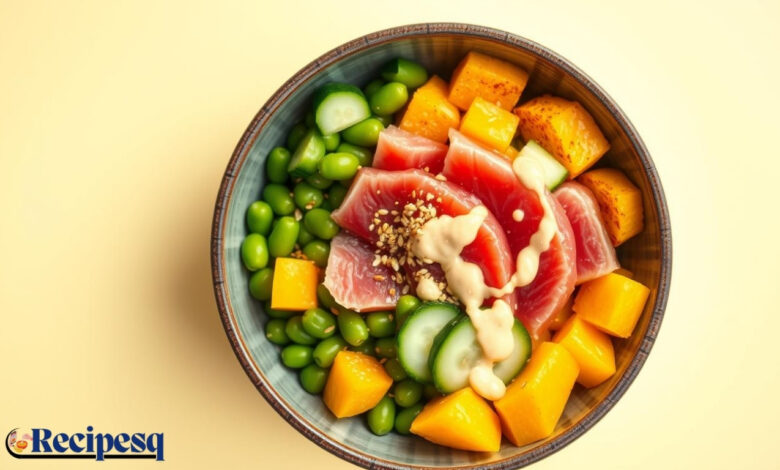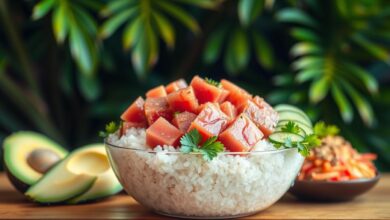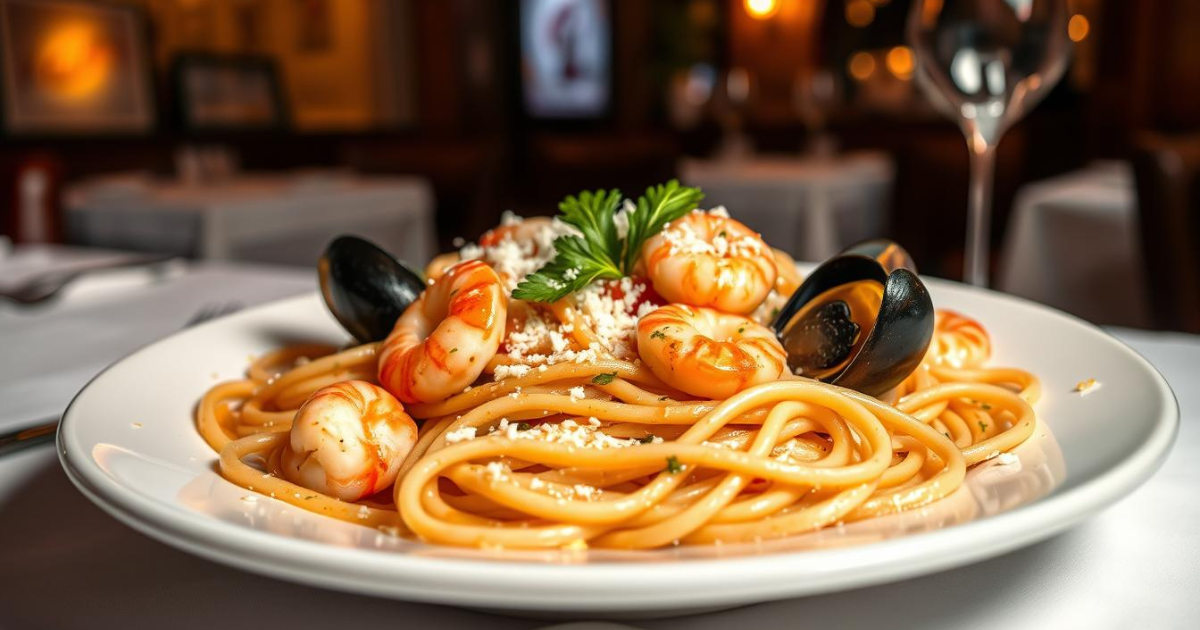Poke Bowl Recipe: Healthy, Flavorful, and Simple

Are you looking for a dish that’s both nourishing and bursting with flavor? You’re in the right place! A poke bowl is a perfect meal that combines the freshness of sashimi-grade fish, the crunch of vegetables, and the richness of savory sauces, all in one bowl.

Making a delicious poke bowl at home is simpler than you think. With a few fresh ingredients and some basic kitchen tools, you can create a meal that’s not only healthy but also tailored to your taste preferences. Whether you’re a seasoned foodie or a culinary newcomer, this simple poke bowl recipe will guide you through the process.
Key Takeaways
- Learn how to make a healthy poke bowl with fresh ingredients.
- Discover the simplicity of preparing a poke bowl at home.
- Customize your poke bowl to suit your taste preferences.
- Understand the nutritional benefits of a poke bowl.
- Get tips on selecting the freshest ingredients for your poke bowl.
What is a Poke Bowl? The Hawaiian Delicacy Explained
A poke bowl is more than just a meal; it’s a culinary experience rooted in Hawaiian tradition and a commitment to freshness. This dish has evolved from a local favorite to a global phenomenon, captivating food enthusiasts with its vibrant colors and tantalizing flavors.
The Origins and Cultural Significance
Poke bowls originated in Hawaii, where “poke” means “to cut or slice” in Hawaiian. This dish has its roots in traditional Hawaiian cuisine, where fishermen would season their catch with local ingredients like seaweed, soy sauce, and sesame oil. The cultural significance of poke bowls lies in their connection to the ocean and the land, reflecting Hawaii’s rich maritime culture and emphasis on community sharing.
“Poke is a dish that embodies the aloha spirit, bringing people together through its simplicity and freshness.”
Why Poke Bowls Are a Nutritional Powerhouse
Poke bowls are not only delicious but also packed with nutrients. The raw fish provides a rich source of omega-3 fatty acids, while the vegetables and seaweed add fiber, vitamins, and minerals. A traditional poke bowl recipe is inherently healthy, making it an attractive option for those seeking a balanced meal. By incorporating sustainable and fresh ingredients, you can enjoy a nutritious meal that supports overall well-being.
The Basic Components of a Traditional Poke Bowl
A traditional poke bowl typically consists of fresh, sashimi-grade fish marinated in a mixture of soy sauce, sesame oil, and other local flavors, served over a bed of rice or mixed greens. Additional components may include vegetables like cucumbers, carrots, and avocado, as well as seaweed salad. Understanding these basic components is key to creating an authentic poke bowl recipe that captures the essence of Hawaiian cuisine.
By embracing the principles of a traditional Hawaiian poke bowl recipe, you can enjoy a meal that is both flavorful and nutritious. Whether you’re looking to explore new flavors or simply seeking a healthy meal option, the poke bowl is an excellent choice.
Essential Ingredients for the Perfect Poke Bowl
Crafting the perfect poke bowl starts with selecting the freshest and highest-quality ingredients. The beauty of a poke bowl lies in its customization and the harmony of its components.
Selecting the Right Fish: Ahi Tuna and Alternatives
The star of any poke bowl is the fish. Ahi tuna is a popular choice due to its meaty texture and rich flavor. However, other fish like salmon, yellowtail, and even tofu for a vegetarian option can be great alternatives.
When choosing fish, freshness is paramount. Look for sushi-grade fish that’s been properly handled and stored.
Fresh Produce and Vegetables to Include
Fresh produce adds crunch, flavor, and color to your poke bowl. Common choices include diced cucumbers, carrots, and avocado. You can also include pickled ginger for an added zing.
Feel free to get creative with your vegetable choices, incorporating what’s in season and your personal favorites.
Choosing Your Base: Rice, Greens, or Mixed
The base of your poke bowl can be traditional sushi rice, mixed greens for a low-carb option, or a mix of both for a balanced meal.
Sushi rice is a classic choice, flavored with rice vinegar and sometimes sesame seeds. Mixed greens offer a lighter, fresher base, while combining both gives you the best of both worlds.
Sauces and Seasonings That Make the Difference
Sauces and seasonings elevate your poke bowl from good to great. Traditional options include soy sauce, sesame oil, and furikake. You can also experiment with sriracha for some heat or yuzu for a citrusy twist.
| Ingredient | Description | Example |
|---|---|---|
| Fish | Sushi-grade fish for the main protein | Ahi Tuna, Salmon |
| Base | The foundation of the bowl | Sushi Rice, Mixed Greens |
| Produce | Fresh vegetables for added flavor and texture | Cucumbers, Avocado |
| Sauces/Seasonings | Flavor enhancers | Soy Sauce, Furikake |
Classic Poke Bowl Recipe: Step-by-Step Instructions
Creating a classic poke bowl is easier than you think with our step-by-step guide. This Hawaiian delicacy has gained worldwide popularity due to its simplicity, freshness, and flavor. By following these instructions, you’ll be able to prepare a healthy and delicious poke bowl in the comfort of your own home.
Preparing Your Fish Safely
The foundation of a great poke bowl is the fish. For a classic poke bowl, ahi tuna is the most commonly used fish due to its rich flavor and firm texture. When handling raw fish, it’s crucial to follow safety guidelines to avoid foodborne illness. Ensure that your fish is sashimi-grade and handle it with clean utensils and on a clean surface. Cut the fish into small, bite-sized pieces and refrigerate until you’re ready to marinate it.
Always check the expiration date of your fish and purchase it from a reputable source. If you’re unsure about handling raw fish, consider alternatives like cooked or marinated fish options.
Creating the Perfect Marinade
The marinade is what gives poke its signature flavor. In a bowl, whisk together soy sauce, sesame oil, and a squeeze of fresh lime juice. Add a minced garlic clove and a grated piece of ginger for an extra depth of flavor. You can also add a bit of honey if you prefer a slightly sweeter marinade. Place the fish pieces in the marinade and gently toss to coat. Cover the bowl with plastic wrap and refrigerate for at least 30 minutes to allow the flavors to meld.

As you wait, you can start preparing the other components of your poke bowl. The key is to balance flavors and textures, so don’t be afraid to get creative with your choices.
Assembling Your Bowl Like a Pro
Once your fish is marinated, it’s time to assemble your bowl. Start with a base of sushi rice or mixed greens, depending on your preference. Add the marinated fish on top, followed by your choice of vegetables and garnishes. Traditional poke bowls often include diced cucumbers, carrots, and avocado, but feel free to customize with your favorite ingredients.
To add some crunch, sprinkle toasted sesame seeds or chopped macadamia nuts on top. Finally, drizzle any remaining marinade or additional sauces like sriracha or ponzu over the bowl for extra flavor.
Timing and Storage Tips
Poke bowls are best consumed fresh, but you can prepare components ahead of time. Cooked rice and chopped vegetables can be stored in the refrigerator for a day. However, the fish should be marinated just before serving to maintain its freshness and texture.
If you have leftovers, store the components separately in airtight containers and refrigerate. When you’re ready to eat, simply reassemble the bowl. “The key to a great poke bowl is freshness,” says a renowned chef. “Using high-quality, fresh ingredients makes all the difference in the flavor and overall experience.”
Delicious Poke Bowl Variations to Try at Home
The beauty of poke bowls lies in their customizability, enabling you to create a dish that’s both healthy and flavorful. Whether you’re looking for a vegetarian option, something spicy, or a low-carb adaptation, there’s a poke bowl variation to suit every taste and dietary need.
Vegetarian and Vegan Poke Bowl Options
For a vegetarian or vegan poke bowl, you can substitute the fish with marinated and baked tofu or tempeh. Include a variety of colorful vegetables such as cucumbers, carrots, and avocado to add texture and flavor. You can also use seaweed salad or pickled ginger to give it an authentic poke bowl taste.
Some great vegetarian poke bowl ingredients include roasted sweet potatoes, edamame, and mixed greens. For added protein, consider incorporating marinated and grilled portobello mushrooms or seitan.
Spicy Poke Bowl Recipe
If you like a bit of heat in your meal, a spicy poke bowl is a great option. You can add diced jalapeños or serrano peppers to your marinade for an extra kick. Another option is to use spicy mayo or sriracha sauce as a topping.
To make a spicy poke bowl, start with a base of sushi rice or mixed greens, then add your choice of protein (such as tuna or tofu), and top it with spicy ingredients like diced mango or sliced radishes.
California-Style Poke Bowl
California-style poke bowls often feature a fusion of traditional Hawaiian flavors with California cuisine. This might include ingredients like avocado, bacon, or crab. You can also add some heat with diced jalapeños or a drizzle of sriracha.
A California-style poke bowl might include a mix of sashimi-grade tuna, crab, and avocado, served over a bed of mixed greens or sushi rice. Don’t forget to add some crunchy elements like toasted sesame seeds or chopped nuts.
Low-Carb and Keto-Friendly Adaptations
For a low-carb or keto-friendly poke bowl, you can replace the traditional sushi rice with cauliflower rice or a mixed green salad. You can also add healthy fats like avocado, nuts, or seeds to keep you full and satisfied.
Some great low-carb poke bowl ingredients include grilled chicken or salmon, mixed greens, and a variety of vegetables like cucumbers, bell peppers, and carrots. Consider adding a citrus-based dressing or a sprinkle of sesame seeds for extra flavor.
| Poke Bowl Variation | Key Ingredients | Dietary Benefit |
|---|---|---|
| Vegetarian/Vegan | Tofu, tempeh, mixed vegetables | Plant-based protein source |
| Spicy | Jalapeños, sriracha, spicy mayo | Adds metabolism boost |
| California-Style | Avocado, bacon, crab | Combines flavors and textures |
| Low-Carb/Keto | Cauliflower rice, avocado, nuts | Reduces carbohydrate intake |

Conclusion: Mastering the Art of Homemade Poke Bowls
Now that you’ve learned the basics of creating a delicious poke bowl, it’s time to put your newfound skills to the test. By mastering the poke bowl recipe, you can enjoy a healthy, flavorful meal at home. Experimenting with different ingredients and variations is key to making homemade poke bowls a staple in your culinary routine.
With the knowledge gained from this article, you’re well on your way to creating your perfect homemade poke bowl. Try combining fresh, sustainable ingredients with your favorite sauces and seasonings to create a dish that’s both nourishing and delicious. As you continue to refine your poke bowl recipe, you’ll discover the joy of customizing each bowl to suit your taste preferences.
By incorporating poke bowls into your meal rotation, you’ll not only be treating yourself to a tasty and healthy meal but also exploring the rich culinary heritage of Hawaii. So, take the first step in mastering your homemade poke bowl and start creating your own signature poke bowl recipes today.




